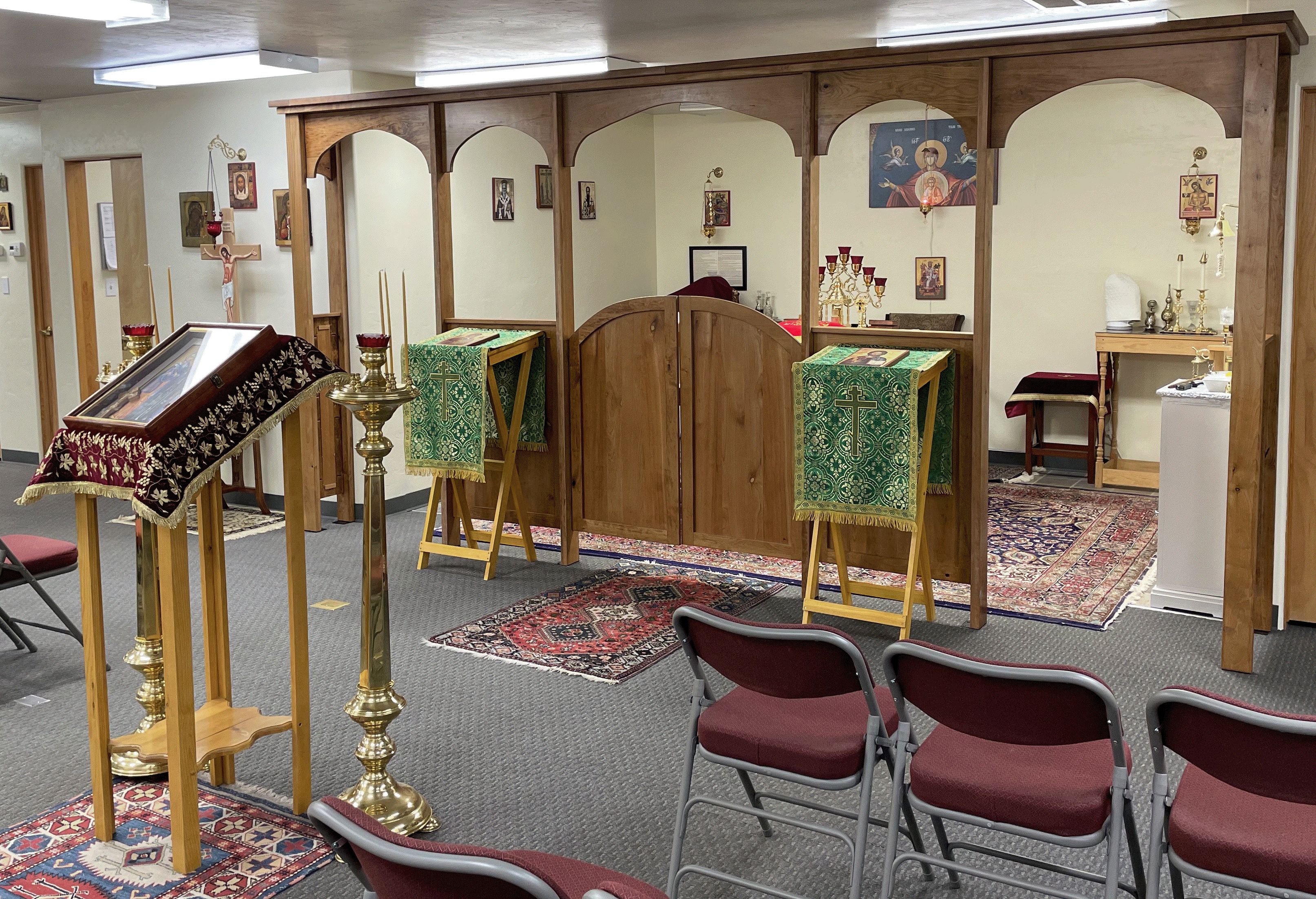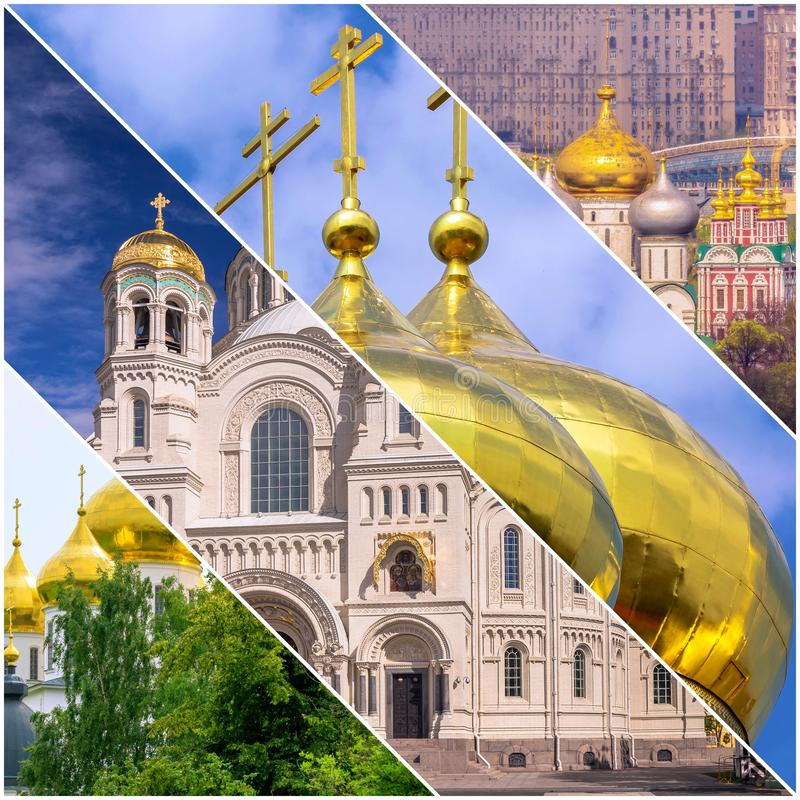|
What to Expect at Holy Wisdom Orthodox Church We are always blessed to have visitors, and we are truly glad to welcome everyone to our Church. Because Orthodox Christianity is unfamiliar to many people on the Western Slope of Colorado — and it was new to many of us as well! — we have written the following to help you know what to expect. Getting to the Church Our Directions will help you find us. We are located in Grand Junction, Colorado on the corner of of North 4th Street & Kennedy Street, just two blocks east of Sherwood Park and two blocks west of Grand Junction High School. See our Calendar for the schedule of service times and events. Our typical weekly schedule includes services on Wednesday and Saturday evenings, as well as on Sunday mornings. What You’ll Find We are a mission parish. Our church building is very humble, but filled with peace and love. The beauty of Orthodox worship must be experienced to be understood. The Divine Liturgy expresses the entire Christian faith in a continuous song of praise and prayer addressed to God. It is focused on God, not on us.
Participating in the Services Posture is part of Orthodox practice, as we worship God with our bodies as well as with our words. You will see that people at times bow, make the sign of the Cross, etc. If you are not Orthodox, of course no one expects you to do these things — just sit or stand and listen, and participate to the degree that you wish. No one will judge you! Communion is understood as a sign of full commitment to the Orthodox Christian Faith and of active participation in the Body of Christ, which begin with the Orthodox Mysteries (Sacraments) of Baptism and Chrismation. The Orthodox Christian belief is that during the Divine Liturgy bread and wine are changed by the Holy Spirit to become the Body and Blood of Christ. Their reception as Holy Communion is therefore regarded as exceptionally sacred. These Holy Gifts are respected and guarded with extraordinary care. According to ancient Christian tradition, an Orthodox Priest may only administer Holy Communion to Orthodox Christians who have prepared themselves to receive the Holy Gifts by following the Commandments of God, living according to Orthodox moral tradition, and Confessing regularly in the Mystery of Repentance. Orthodox Christians recite Prayers of Preparation on the evening before, and on the morning of, the Divine Liturgy. They also fast by abstaining from all food or drink following dinner on the evening before until after receiving Holy Communion the next day. Those who are not known to the Priest will speak to him (or ask a parishioner to send word to him) ahead of time so he will know they are Orthodox Christians in good standing. Antídoron is Blessed Bread placed in a basket on a side table. This is not Holy Communion, but is taken reverently by the faithful after receiving Holy Communion to ensure that they completely swallow the Body and Blood of Christ. Many of the faithful customarily take a piece of Antídoron at the end of the Liturgy to bring home. They will eat a portion as a blessing each day following their morning prayers. Standing and kneeling are the Biblical postures for prayer, and Orthodox traditionally stand throughout the services. For most people this takes some “getting in shape,” so feel free to sit as you may find necessary. We do have chairs in the church for those who wish or need to sit. Kneeling is considered a gesture of deepest reverence or of repentance, thus we do not kneel as often on Sunday – which is the Day of Resurrection – as we do at weekday services and during Great Lent. Children are always welcome in the Orthodox Church, and we apply simple common sense to dealing with their behavior. We understand that it is appropriate and beneficial for children to be in the services as much as possible, thus there is typically no nursery in an Orthodox church. If brought regularly to church, children will learn to settle down, and it is surprising how much even toddlers absorb. It is not a problem if they move about quietly; most of us are raising, or have have raised, children ourselves and we are used to some movement. If you have children, simply be considerate – of them as well as of other worshippers – and take them out briefly when they become very noisy or restless, especially during the sermon. Visitors are Always Welcome for we are mindful of the Scripture, “Do not forget to greet strangers, for by so doing some have unwittingly greeted angels” (Hebrews 13:2). We try to be quiet during the services so as to focus on our worship, but please do not hesitate to ask one of the faithful for help. They will be glad to bring you a Service Book (and help you find the current place in the service) and also to bring you a weekly bulletin. We will, of course, answer any immediate questions you may have. We might appear like we are ignoring you but this is not so – we are very aware of your presence and will not mind in the least if you ask us for assistance. After Sunday services we have a fellowship hour, a time of food and drink together either inside the church or outside in the parking lot (weather permitting!). You are invited to join us so we can get to know each other. No one will ever put any pressure on you to join the Church; many people “visit” our Church for years. Please relax and feel at ease. The Divine Liturgy The usual Sunday morning service at 9:30 am is called the “Divine Liturgy.” With the sermon, it lasts about an hour and a forty-five minutes. It includes:
Saturday Evening Vespers On Saturday Evenings the faithful gather in the church for the Evening Worship, a Service called Vespers (Evensong), which lasts about forty-five minutes. Vespers is a preparation, not a substitute, for worship at the Sunday Liturgy. It consists of Psalms – especially Psalms 1, 104(103), 141(140), 142(141), and 127(126) – the “evening offering of incense,” and the noteworthy hymn “O Gladsome Light” which Saint John Chrysostom referred to in the fourth century as an “ancient Christian Hymn” with its roots in the Old Testament Jewish evening Synagogue Service. Another Scriptural hymn is “Lord, now lettest Thou Thy servant depart in peace” (cf. Luke 2:29). The Service of Vespers recapitulates the history of mankind, from creation (Psalm 104(103), the Fall (Psalm 142(141), the incarnation (“O Gladsome Light”), and the Second Coming (“Lord, Now Lettest Thou...”). Orthodox Christians, in continuity with the Jewish faith before them, begin each new day at sunset; Saturday evening Vespers is therefore the first Service of the Lord’s Day (Sunday). Frequently Asked Questions
What does “Theotókos” mean?
The uncreated God united Himself to created mankind through the humanity of the Theotókos in what is called the Incarnation. This is a great mystery of faith: that God united Himself to mankind through the human womanhood of the virgin maiden, Mary. Our love and respect for her is amplified through our Sacramental union with her Son through Baptism, as well as by our receiving Holy Communion of the Body and Blood of Him Who was born of her. The attention given to Mary in the Church also expresses our faith that Jesus Christ is truly human, born of a woman as we are, and yet always God, the Son and Word of God the Father. Because of this, His human mother can be called the Mother of God; this is another great mystery of faith beyond our full human comprehension. In many hymns she is referred to as a sign of the Church as the beloved “Bride of God” and her exaltation as “more glorious than the Seraphim” is a sign of the exaltation awaiting all who “hear the Word of God and keep it” as she did.
What are Icons?
Icons must be painted according to a strict tradition because they are one important way that the Faith is correctly and unalterably handed down and proclaimed. The art style is a unique type, distinct from other painting techniques, and takes many years of practice under the tutelage of an experienced iconographer to learn. An iconographer must have a blessing from the hierarch (bishop) before painting icons for use in churches and homes. He must also confess, fast, and receive Holy Communion before he begins to paint. An icon is not decoration or merely a pious religious painting; rather, the icon is a holy presence, teaching the truths of the Orthodox faith, helping to guide and to focus the attention of the faithful on God. Icons and crosses are kissed (“venerated”), but never worshipped. The act of veneration is a sign of our belief that in Jesus Christ God took a physical body, and became part of our physical world so we could know Him and be united wholly with Him. In venerating (kissing) an icons we are expressing love and respect toward the individual depicted; this action could be roughly compared to the way that we respect and salute the American flag to show our patriotism and love for our country.
Why do you use incense, vestments, and candles?
You will see the faithful offer a donation for candles which they place in the church. In this way the candle is an offering that accompanies prayer, asking God to receive our petition and to grant His great mercy. Incense is prescribed in worship since the Old Testament period. There was an altar of incense (cf. Exodus 30:1-10) in the Temple. Priests of the Old Testament priesthood offered incense daily (cf. 1 Samuel 2:28) at Matins (Morning Worship) – to coincide with the burnt offerings made at the Altar of Sacrifice – and at Vespers (Evening Worship). On the Day of Atonement the High Priest “made incense to smoke” in the Holy of Holies before the Mercy Seat of the Ark of the Testimony (cf. Leviticus 16:12–13). We continue to burn incense in our worship – both in the church and in our homes – as God spoke: “For from the rising of the sun, even to its going down, My name shall be great among the Gentiles; in every place incense shall be offered to My name, and a pure offering; for My name shall be great among the nations, says the Lord of hosts” (cf. Malachi 1:11).
Why do you use ancient, repeated prayers and hymns?
Some hymns and refrains are repeated for two reasons, First, because we wish to continuously praise the Lord (cf. Psalm 34(33):1). Second, because we want these sacred words to become rooted in our minds. Thus it is certainly not “vain repetition” but a very beneficial way to fix the words of worship constantly in our thoughts and in our very being. The hymns are chanted or sung, rather than spoken, so that we are less conscious of the personality of the individual reader. They are sung without musical accompaniument because the most-noble musical instrument is the one created by God: the human voice.
How can I join the Orthodox Church?
Please know that Orthodox Christians do not proselytize. We will not try to convine or coerce you – or anyone – to accept Orthodox beliefs, traditions, or customs. Nor will we push or hurry anyone to join the Orthodox Church. One of the most important qualities given to us by God is free will, and we absolutely respect the freedom of every person to choose their own beliefs and practices. That being said, we are aways glad to answer your questions about our Church and Orthodox Christianity. We would also be very happy to help you embrace and practice the Orthodox faith. But we will always wait for you to initiate that request. Those wishing to become Orthodox Christians are received as catechumens (learners). They will spend a period of time attending the services and learning the Faith. Catechism classes are typically offered in a parish, specifically structured for catechumens. Catechumens also meet one-on-one with the Parish Priest to discuss their Christian journey. When deemed ready to make a lifetime commitment to Jesus and His Body, the Orthodox Church, they are Baptized in water, Chrismated (“Confirmed”) by anointing, and Communed by receiving the Body and Blood of Christ. They thus become full participants in the life of the Orthodox Church, and are members of the worldwide Orthodox Church which presently comprises about 350 million believers. They join those who faithfully accept and believe those things which Christ taught, that His Apostles preached, and that the Orthodox Church has faithfully maintained unchanged. They practice the same traditions as those of faithful throughout past generations and over the centuries of Orthodox Christianity.
|



